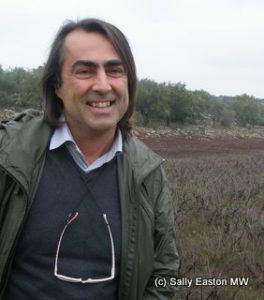Polvanera

Filippo Cassano
Filippo Cassano of Polvanera owns vineyards around Gioia del Colle on the Murge plateau, some 300 to 450m above sea level. He farms 40 hectares, 25 of which are his own, including some 40-50 year old primitivo bush vines, or alberelli, his grandfather planted, directly into the superficial rock. While much of his vineyard area is dedicated to primitivo, Cassano also makes aleatico, aglianico, fiano minutolo, falanghina and moscato.
His first vintage was 2005, the same year his partially subterranean cellar was carved out of the limestone and terra rossa soils.
Up where his grandfather’s vines are, Cassano said “we have more breezes to dry out the grapes here, and we’re maybe one of the latest areas for picking.” In 2011 they picked in October. At this higher altitude he added, compared to vineyards around 200 metres lower, harvest can be a month later. In addition to which he said “September is good month for day-night temperature differences, so if you can hold off from picking, it’s good for the perfume of the wine.”
Cassano has a strong philosophy of oak avoidance. He said proudly, “my wine contacts only steel and glass”, and some pipework, he conceded. He tried working with barrique in his first year, “but it so changed the wine that I couldn’t find the typical dark fruit of primitive, I could only taste vanilla.” At the time, he added “I was swimming against the tide of barriquistas, and of blending primitivo with French varieties, because I was pure primitivo and no wood.” But “now, my choices are more appreciated around the world. The current movement is in favour of the styles I’m making.”
Cassano also makes an intriguing, and tasty, traditional method sparkling primitivo, with ten months on the lees. It’s made from the secondary bunches which mature a couple of weeks after the main harvest, though he said “I pick them before the whole of the two weeks so they’re slightly under-ripe, with around 9-10% potential alcohol and 9-10g/l of acid.”
After some experimentation, he’s settled on a two hour skin contact before the first fermentation. But as this results in a colour that he feels isn’t vibrant enough, he adds strongly coloured primitivo in the dosage. This wine represents some 10% of his total production.
Why the estate is not eponymously named is because Cassano decided to take the name of the farm instead. He explained “the centre part of the farm was built in 1820 of local rocks, and the original family was nicknamed ‘soot’ (polvagnor) because they used to burn wood to make charcoal.
Tasting notes, in situ, November 2011
Polvanera, Metodo Classico, Rosé Brut
100% primitivo. 2011 disgorgement, date on the label. 12%
Lovely bright pink colour. Nice freshness, with cherry fruits. Dosage at the high end for brut, so tastes (to me) off dry rather than dry, but this is a good fun wine.
Polvanera, Primitivo 17, 2008, Gioia del Colle DOC
From 60 year old alberelli, on clay rich soils. 16%.
Juicy, dark berries, sweet, pure fruit. Huge concentration, alcohol kick at the end, though considerably less than I might anticipate for 16%. Lovely, dense, round, sweetness, rich, fleshy, raspberry jam and blackberries, but I’m not sure I’d want to drink a whole glass. Great purity of fruit with a core of freshness amid the sweetness and alcohol. (Learn it is 9-10g/l RS after the tasting.)
Polvanera, Primitivo 16, 2008, Gioia del Colle DOC
From old alberelli, on iron-calcareous rocky soil.
Fragrant floral, violet perfume, elegant nose and palate attack, with hint of light chalky texture. Upright, intense, well-deported. Also huge concentration, with good focus and intensity of sweet/ripe red berries. This has super balance, length and line, and I don’t feel the (16%) alcohol on this one. Vg. (Learn it is 2-3g/l RS after the tasting.)
Polvanera, Primitivo 14, 2008 Gioia del Colle DOC
From old alberelli and cordon spur trained. Calcareous clay soils. 14%
Dark spices and berries, hints of aromatic plums and cherries. Nice texture and balance, succulence of fruit and freshness. More approachable (half the price) than No. 16 or 17.
My trip to visit and judge wine in Puglia was sponsored by the Puglia Best Wine Consortium.



